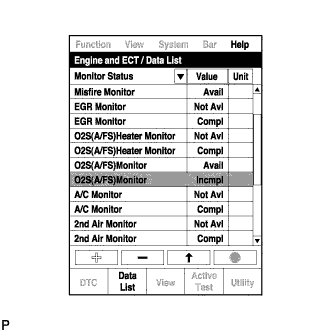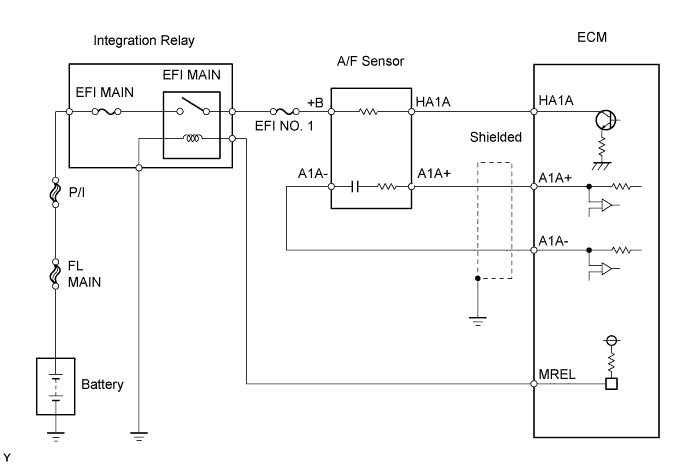CHECK ANY OTHER DTCS OUTPUT (IN ADDITION TO DTC P2A00)
INSPECT AIR-FUEL RATIO SENSOR (HEATER RESISTANCE)
CHECK HARNESS AND CONNECTOR (ECM - AIR-FUEL RATIO SENSOR)
PERFORM CONFIRMATION DRIVING PATTERN
CHECK WHETHER DTC OUTPUT RECURS (DTC P2A00)
PERFORM CONFIRMATION DRIVING PATTERN
CHECK WHETHER DTC OUTPUT RECURS (DTC P2A00)
DTC P2A00 A/F Sensor Circuit Slow Response (Bank 1 Sensor 1) |
- HINT:
- Sensor 1 refers to the sensor mounted in front of the Three-Way Catalytic Converter (TWC) and located near the engine assembly.
DESCRIPTION
Refer to DTC P2195 (RAV4_ACA30 RM000000WC408DX_01.html).| DTC No. | DTC Detection Condition | Trouble Area |
| P2A00 | Calculated value of air-fuel ratio (A/F) sensor response rate deterioration level less than threshold (2 trip detection logic) |
|
MONITOR DESCRIPTION
After the engine is warmed up, the ECM performs air-fuel ratio feedback control to maintain the air-fuel ratio at the stoichiometric level. In addition, active A/F control is performed for approximately 10 seconds after the preconditions are met in order to measure the A/F sensor response rate. During active A/F control, the ECM forcibly increases and decreases the injection volume a certain amount, based on the stoichiometric air-fuel ratio learned during normal air-fuel ratio control, and measures the A/F sensor response rate. The ECM receives a signal from the A/F sensor while performing active A/F control and uses it to calculate the A/F sensor response rate deterioration level.If the A/F sensor response rate deterioration level is less than the threshold, the ECM interprets this as a malfunction and sets the DTC.

CONFIRMATION DRIVING PATTERN
- HINT:
- Performing this confirmation pattern will activate the A/F sensor response monitor.

(a) Connect the intelligent tester to the DLC3.
- (b) Turn the ignition switch on (IG).
- (c) Turn the tester ON.
- (d) Clear DTCs (if set) (RAV4_ACA30 RM000000PDK0AHX.html).
- (e) Select the following menu items: Powertrain / Engine and ECT / Data List / Monitor Status.
- (f) Check that O2S(A/FS) Monitor is Incmpl.
- (g) Start the engine and warm it up.
- (h) Drive the vehicle at a constant speed of between 25 mph and 75 mph (40 km/h and 120 km/h) for 3 minutes.
- (i) Check that the status of the O2S(A/FS) Monitor is Compl.
- (j) Select the following menu items: Powertrain / Engine and ECT / DTC.
- (k) Check if any DTCs (any pending DTCs) are set.
WIRING DIAGRAM

INSPECTION PROCEDURE
- HINT:
- Intelligent tester only:
- Malfunctioning areas can be identified by performing the Control the Injection Volume for A/F Sensor function provided in the Active Test. The Control the Injection Volume for A/F Sensor function can help to determine whether the Air-Fuel Ratio (A/F) sensor, Heated Oxygen (HO2) sensor and other potential trouble areas are malfunctioning.
- The following instructions describe how to conduct the Control the Injection Volume for A/F Sensor operation using the intelligent tester.
- (a) Connect the intelligent tester to the DLC3.
- (b) Start the engine and turn the tester ON.
- (c) Warm up the engine at an engine speed of 2,500 rpm for approximately 90 seconds.
- (d) On the tester, select the following menu items: Powertrain / Engine and ECT / Active Test / Control the Injection Volume for A/F Sensor.
- (e) Perform the Control the Injection Volume for A/F Sensor operation with the engine idling (press the RIGHT or LEFT button to change the fuel injection volume).
- (f) Monitor the voltage outputs of the A/F and HO2 sensors (AFS B1 S1 and O2S B1 S2) displayed on the tester.
- HINT:
- The Control the Injection Volume for A/F Sensor operation lowers the fuel injection volume by 12.5% or increases the injection volume by 25%.
- The sensors react in accordance with increases and decreases in the fuel injection volume.
- Standard:
Tester Display
(Sensor)Injection Volume Status Voltage AFS B1 S1
(A/F)+25% Rich Less than 3.0 -12.5% Lean More than 3.35 O2S B1 S2
(HO2)+25% Rich More than 0.5 -12.5% Lean Less than 0.4
- NOTICE:
- The A/F sensor has an output delay of a few seconds and the HO2 sensor has a maximum output delay of approximately 20 seconds.
| Case | A/F Sensor (Sensor 1) Output Voltage | HO2 Sensor (Sensor 2) Output Voltage | Main Suspected Trouble Area | ||
| 1 | Injection Volume +25% -12.5% |  | Injection Volume +25% -12.5% |  | - |
| Output Voltage More than 3.35 V Less than 3.0 V |  | Output Voltage More than 0.5 V Less than 0.4 V |  | ||
| 2 | Injection Volume +25% -12.5% |  | Injection Volume +25% -12.5% |  |
|
| Output Voltage Almost no reaction |  | Output Voltage More than 0.5 V Less than 0.4 V |  | ||
| 3 | Injection Volume +25% -12.5% |  | Injection Volume +25% -12.5% |  |
|
| Output Voltage More than 3.35 V Less than 3.0 V |  | Output Voltage Almost no reaction |  | ||
| 4 | Injection volume +25% -12.5% |  | Injection Volume +25% -12.5% |  |
|
| Output Voltage Almost no reaction |  | Output voltage Almost no reaction |  | ||
- Following the Control the Injection Volume for A/F Sensor procedure enables technicians to check and graph the voltage outputs of both the A/F and HO2 sensors.
- To display the graph, select the following menu items on the tester: Powertrain / Engine and ECT / Active Test / Control the Injection Volume for A/F Sensor / Enter / View / AFS B1 S1 and O2S B1 S2.
- HINT:
- DTC P2A00 may be set when the air-fuel ratio is stuck rich or lean.
- A low A/F sensor voltage could be caused by a rich air-fuel mixture. Check for conditions that would cause the engine to run rich.
- A high A/F sensor voltage could be caused by a lean air-fuel mixture. Check for conditions that would cause the engine to run lean.
- Read freeze frame data using the intelligent tester. Freeze frame data records the engine condition when malfunctions are detected. When troubleshooting, freeze frame data can help determine if the vehicle was moving or stationary, if the engine was warmed up or not, if the air-fuel ratio was lean or rich, and other data from the time the malfunction occurred.
| 1.CHECK ANY OTHER DTCS OUTPUT (IN ADDITION TO DTC P2A00) |
Connect the intelligent tester to the DLC3.
Turn the ignition switch on (IG).
Turn the tester ON.
Select the following menu items: Powertrain / Engine and ECT / DTC.
Read DTCs.
- Result:
Display (DTC Output) Proceed to P2A00 A P2A00 and other DTCs B
|
| ||||
| A | |
| 2.INSPECT AIR-FUEL RATIO SENSOR (HEATER RESISTANCE) |
 |
Disconnect the B7 A/F sensor connector.
Measure the resistance of the A/F sensor connector.
- Standard resistance:
Tester Connection Specified Condition HA1A (1) - +B (2) 1.8 Ω to 3.4 Ω at 20°C (68°F) HA1A (1) - A1A- (4) 10 kΩ or higher
Reconnect the A/F sensor connector.
|
| ||||
| OK | |
| 3.CHECK HARNESS AND CONNECTOR (ECM - AIR-FUEL RATIO SENSOR) |
 |
Disconnect the B7 A/F sensor connector.
Disconnect the B32 ECM connector.
Measure the resistance.
- Standard resistance (Check for open):
Tester Connection Specified Condition HA1A (B7-1) - HA1A (B32-109) Below 1 Ω
- Standard resistance (Check for short):
Tester Connection Specified Condition HA1A (B7-1) or HA1A (B32-109) - Body ground 10 kΩ or higher
Reconnect the A/F sensor connector.
Reconnect the ECM connector.
|
| ||||
| OK | |
| 4.PERFORM CONFIRMATION DRIVING PATTERN |
| NEXT | |
| 5.CHECK WHETHER DTC OUTPUT RECURS (DTC P2A00) |
Connect the intelligent tester to the DLC3.
Turn the ignition switch on (IG) and turn the tester ON.
Select the following menu items: Powertrain / Engine and ECT / DTC.
Read pending DTCs.
- Result:
Display (DTC Output) Proceed to P2A00 A No output B
|
| ||||
| A | |
| 6.REPLACE AIR-FUEL RATIO SENSOR |
| NEXT | |
| 7.PERFORM CONFIRMATION DRIVING PATTERN |
| NEXT | |
| 8.CHECK WHETHER DTC OUTPUT RECURS (DTC P2A00) |
Connect the intelligent tester to the DLC3.
Turn the ignition switch on (IG) and turn the tester ON.
Select the following menu items: Powertrain / Engine and ECT / DTC.
Read pending DTCs.
- Result:
Display (DTC Output) Proceed to No output A P2A00 B
|
| ||||
| A | ||
| ||